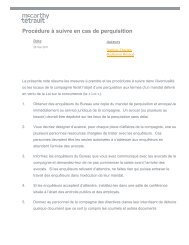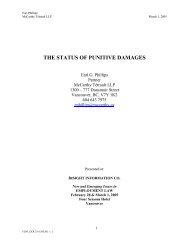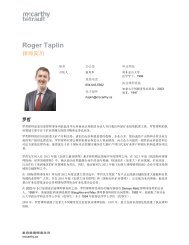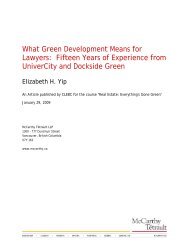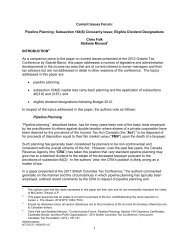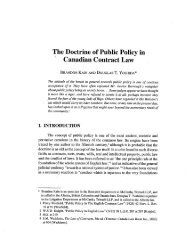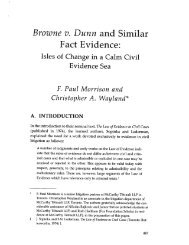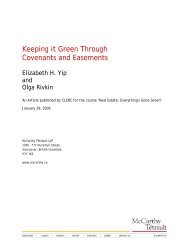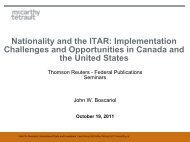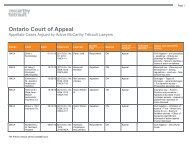1. COMPETITION - McCarthy Tétrault
1. COMPETITION - McCarthy Tétrault
1. COMPETITION - McCarthy Tétrault
Create successful ePaper yourself
Turn your PDF publications into a flip-book with our unique Google optimized e-Paper software.
United Phosphorous had already received a process patent for SAAF in<br />
2001 while the product was introduced in the market and had been gaining<br />
market share. This first approval of an EMR, paves the way for more<br />
favorable EMR decisions till the start of 2005 when the "black box" will be<br />
opened and pharmaceutical patents will gain momentum.<br />
Delhi makes Trade Mark search mandatory before granting manufacturing<br />
license.<br />
In a move to curb the spread and sale of counterfeit drugs, the Drugs<br />
Control Department of the National Territory of Delhi has made search<br />
reports from the Registrar of Trade Marks mandatory before approving any<br />
drug-manufacturing license under a particular brand name.<br />
This initiative by the Delhi Drugs Authority was made pursuant to<br />
observations in the Supreme Court decision of Cadila Health Care Ltd. v.<br />
Cadila Pharmaceuticals Ltd. (decided 26th March 2001). In paragraph 41<br />
of the said judgment, the Supreme Court observed as follows:<br />
"Keeping in view the provisions of Section 17-B of the Drugs and<br />
Cosmetics Act, 1940 which inter alia indicates an imitation or resemblance<br />
of another drug in a manner likely to deceive being regarded as a spurious<br />
drug it is but proper that before granting permission to manufacture a drug<br />
under a brand name the authority under that Act is satisfied that there will<br />
be no confusion or deception in the market. The authorities should<br />
consider requiring such an applicant to submit an official search report<br />
from the Trade Mark office pertaining to the trade mark in question which<br />
will enable the drug authority to arrive at a correct conclusion."<br />
This provision of requiring search reports of trade marks if adopted in the<br />
other States in India will eliminate the chances of approval of a deceptively<br />
similar and look-alike brand of drugs. The Government of India has<br />
appointed Mashelkar Committee to study the various aspects of the<br />
growing threat from spurious drugs and give its report thereon. The<br />
committee has submitted its interim report. The drug regulatory officials<br />
have echoed their feelings and hope to get a positive response from the<br />
report in this regard.<br />
For more information please contact: vaibhav@nishithdesai.com<br />
INDIA<br />
NEW IP LAWS ENTER INTO FORCE<br />
On 15th September 2003, the Indian government effectuated the Trade<br />
Marks Act, 1999 (the "TM Act") and the Geographical Indications of Goods<br />
(Registration and Protection) Act, 1999 (the "GI Act"). India's induction of<br />
these laws fully complies with the Agreement on Trade Related Aspects of<br />
Intellectual Property Rights (the "TRIPS"). While the TM Act replaces<br />
earlier legislation - namely, the Trade and Merchandise Marks Act, 1958 -<br />
the GI Act is a new law that grants statutory protection to the Geographical<br />
Indications of Goods.<br />
Also on 15th September 2003, the government established the Intellectual<br />
Property Appellate Board in Chennai with benches at Ahmedabad, Delhi,<br />
Mumbai, and Kolkata. Now the Appellate Board will hear appeals from the<br />
decisions of the Registrar of Trade Marks and Geographical Indications.<br />
Trade Marks appeals that are currently pending before various High Courts<br />
stand to be transferred to the Appellate Board.<br />
TM ACT<br />
Among other salient features, the TM Act expands the definition of the<br />
term "Trade Mark" to cover the shape of goods, their packaging, and their<br />
combination of colors. It also introduces the registration of both Service<br />
Marks and Collective Marks, granting statutory protection to such marks.<br />
Service Marks were not registrable under the 1958 legislation. Therefore,<br />
prior protection available for Service Marks was through an action of<br />
"passing off." Entries 35 to 42 in the Fourth Schedule of the Trademark<br />
Rules, 2002, list the classes of services. The classification complies with<br />
the Nice Classification of Goods and Services. Collective Marks will be<br />
owned by associations, including those representing accountants,<br />
engineers, or architects. The members of such associations will be allowed<br />
to use the Collective Mark to identify themselves with a level of quality and<br />
other requirements as set by the association.<br />
Additionally, the TM Act:<br />
• permits the filing of multi-class applications.<br />
• increases the term of registration and renewal from seven to ten years.<br />
• recognizes the concept of "well-known Trade Mark," thus prohibits the<br />
registration of a mark that is merely a reproduction or imitation of a<br />
well-known mark, even with respect to different goods or services.<br />
• recognizes offenses relating to falsification of Trade Marks and<br />
application of false trade descriptions - i.e., police may take<br />
cognizance of the complaint without obtaining order from the<br />
magistrate. Police are empowered to search and seize goods or other<br />
instruments involved in committing an offense. However, it will be<br />
mandatory for police to obtain the opinion of the Registrar as to facts<br />
involved in the offense relating to the Trade Mark. This requirement is<br />
likely to delay the search and seizure procedure.<br />
• widens the scope of the definition of the term "infringement." For<br />
instance, use of a registered Trade Mark as a part of a corporate name<br />
or use of a mark in comparative advertising if such advertisement is<br />
contrary to honest practices or is detrimental to its distinctive<br />
character, amounts to infringement.<br />
• obliterates the "disclaimer" provision.<br />
• increases, considerably, the application fees in the Trademarks Rules,<br />
2002. For example, the registration fee has been increased from Rs.<br />
300/- to Rs. 2500/-.<br />
GI ACT<br />
The GI Act was passed with the objective of providing protection to a<br />
Geographical Indication, including any agricultural, natural, or<br />
manufactured goods, or any goods of handicraft or industry, including<br />
foodstuff. Geographical Indications identify a good as originating in a place<br />
where a given quality, reputation, or other characteristic of the good is<br />
essentially attributable to its geographical origin. Among well known<br />
examples of Geographical Indications are "Champagne," "Bordeaux," and<br />
"Chianti." Each region is famous for its wine - the first two are regions in<br />
France and the third is a region in Italy. Examples in the Indian context are<br />
"Banarasi Saris," "Kolhapuri Chappals," "Lakhnowi Kurta," and "Darjeeling<br />
Tea."<br />
A Trade Mark that consists exclusively of marks or indications that serve to<br />
designate the geographical origin of goods or services cannot be<br />
registered under the TM Act. The purpose of a Trade Mark is to denote the<br />
origin of the goods from a particular trader. In the case of a geographical<br />
name, the name would lead the consumer to believe that the goods<br />
originate from that place and thus cause confusion and even deception.<br />
To be recognized as a Geographical Indication, a product must satisfy both<br />
the territorial aspect and that a given quality, reputation, or other<br />
characteristic should be essentially attributable to its geographical origin.<br />
All goods have been categorized in different classes in accordance with the<br />
International Classification of goods for the purposes of registration of<br />
Geographical Indications.<br />
ISSUE 22 SEPTEMBER – OCTOBER 2003 7



